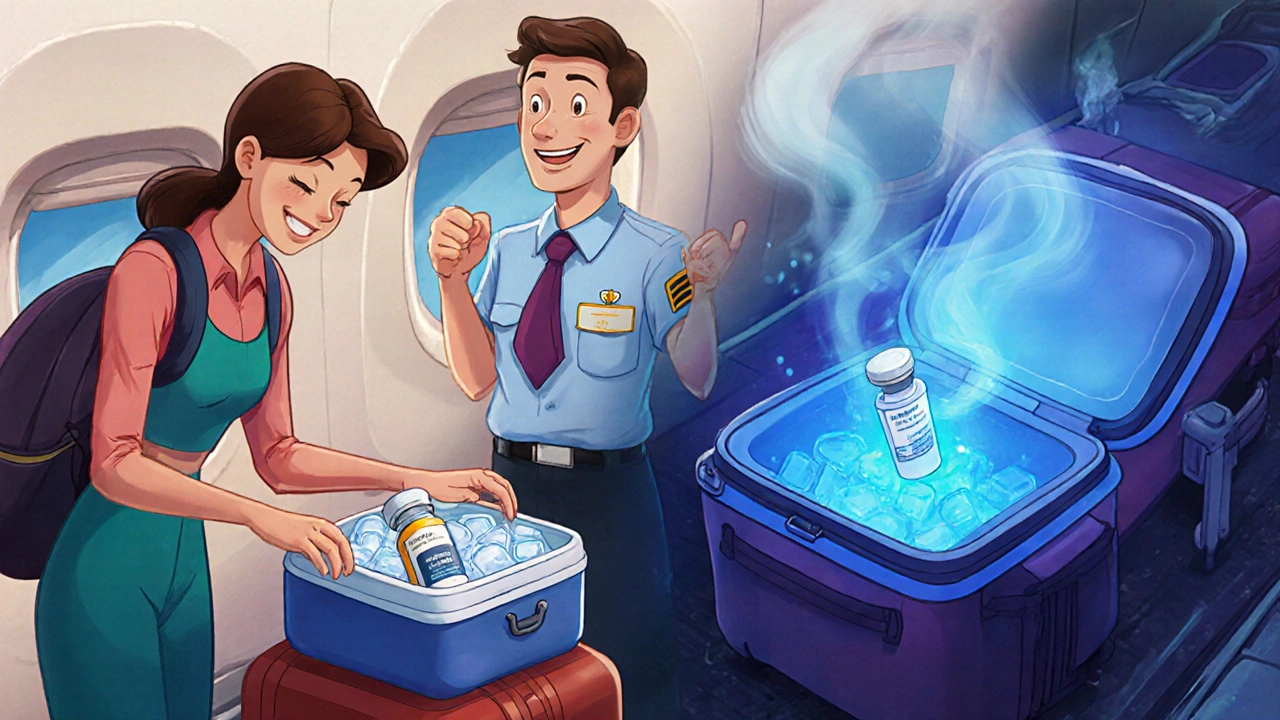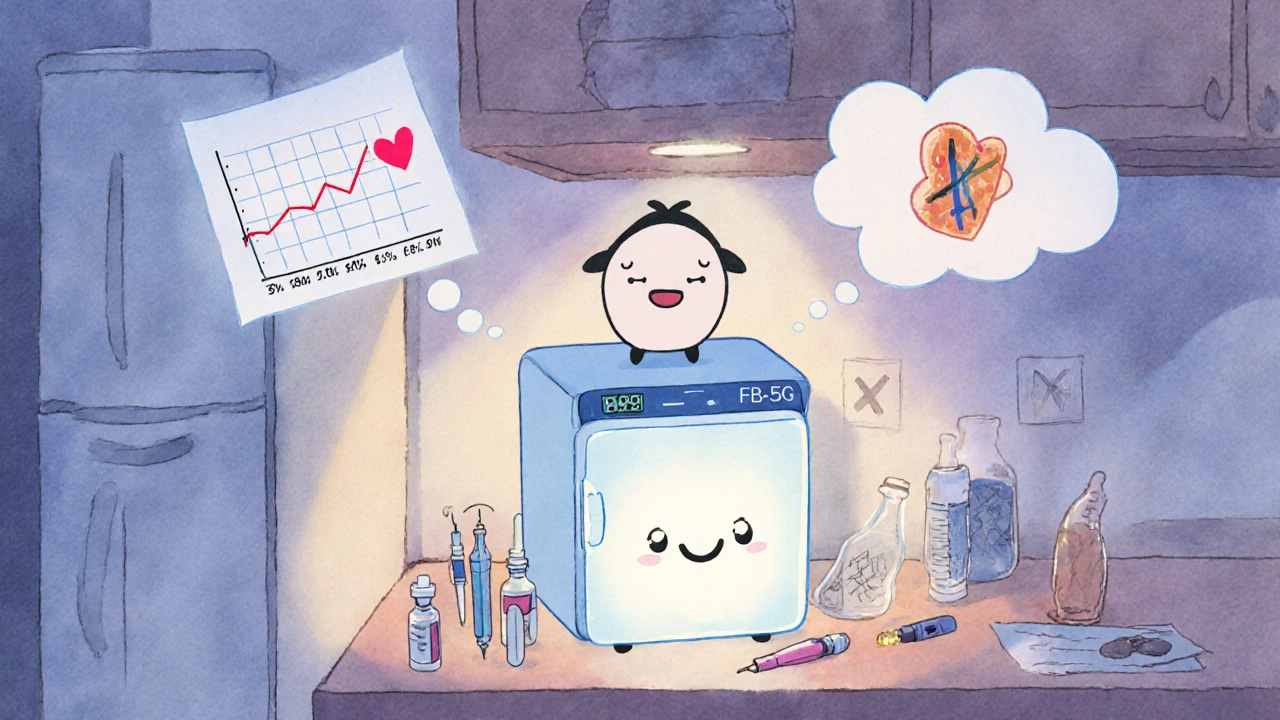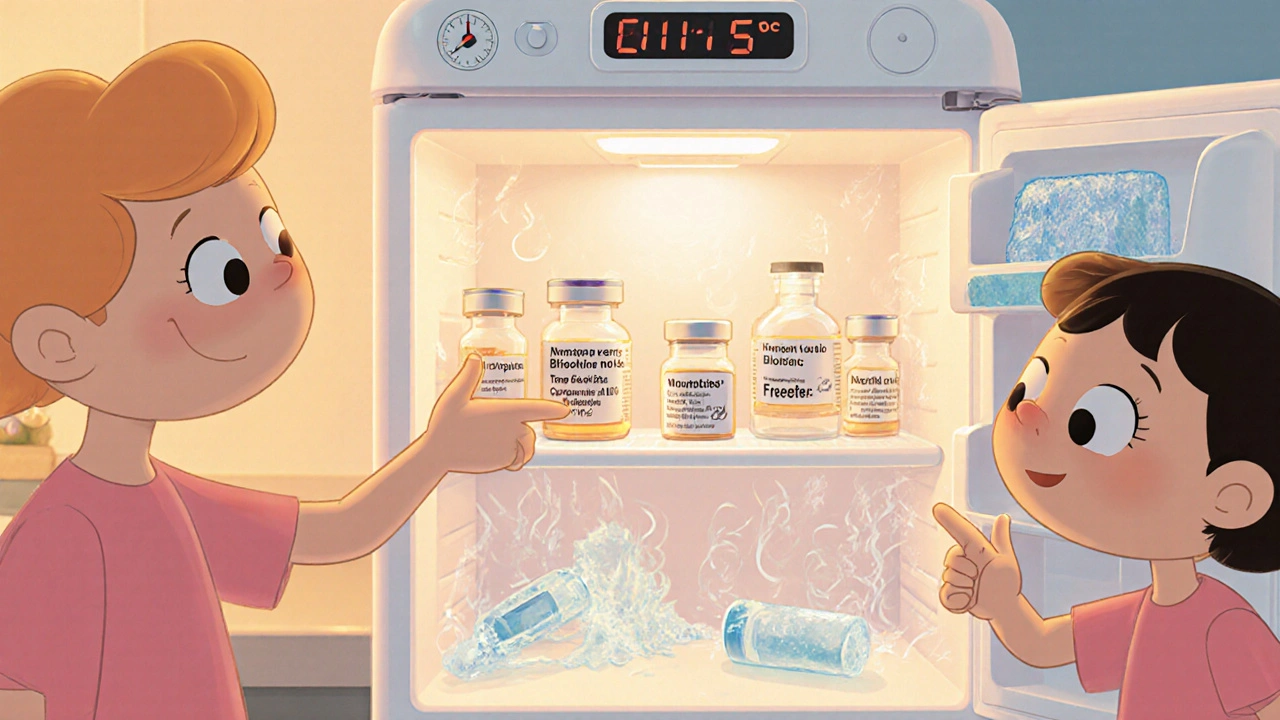When your medication needs to stay cold, it’s not just a convenience-it’s a matter of safety. If you’re taking insulin, biologics for autoimmune diseases, or certain vaccines, storing them wrong could mean your treatment doesn’t work. And that’s not speculation. People have ended up in the hospital because their insulin sat in a hot car or got frozen in the back of the fridge. The truth? Most households don’t know how to store these drugs properly.
Why Refrigeration Isn’t Optional
Not all medicines need the fridge. Antibiotics, blood pressure pills, and cholesterol meds are fine at room temperature. But biologics-drugs made from living cells-are fragile. Insulin, Humira, Enbrel, Remicade, and many cancer treatments fall into this category. They’re essentially proteins. Heat breaks them down. Freezing shatters their structure. Once damaged, they can’t be fixed by thawing or shaking. The science is clear: these drugs must be kept between 2°C and 8°C (36°F to 46°F). That’s the standard set by the U.S. Pharmacopeia and followed by the FDA and WHO. Go above 8°C, and potency drops. Go below 0°C, and you risk permanent damage. A 2023 study found that some biologics lose half their strength in just 24 hours at 25°C. Insulin exposed to 37°C for two days can lose 30-40% of its effect. That’s not a small drop-it’s enough to send blood sugar soaring.What Medications Need the Fridge?
Here’s a quick list of common refrigerated medications:- Insulin (Lantus, Humalog, NovoRapid, etc.)-must be refrigerated until first use. After opening, most can stay at room temperature (up to 30°C) for 28-30 days.
- Biologics (Humira, Enbrel, Remicade, Orencia)-require 2°C-8°C until opened. Some can be stored at up to 30°C for up to 6 months after opening, but never beyond the expiration date.
- Vaccines (Shingrix, MMR, flu shots)-strictly 2°C-8°C. No exceptions. Even brief exposure to heat can ruin them.
- Certain antibiotics (like reconstituted Augmentin or some IV antibiotics)-only if the label says so.
- Injectable hormones (growth hormone, some fertility drugs).
Always check the label. Some generics don’t include clear instructions. If you’re unsure, call your pharmacist. Don’t guess.
Your Kitchen Fridge Isn’t Safe
Most people store these meds in the main compartment of their household fridge. Big mistake. Household fridges aren’t designed for medicine. They swing in temperature constantly. A 2022 study found that the back wall of a typical fridge stays around 3.4°C-perfect. But the door shelves? They average 11.3°C. That’s way too warm. Even the middle shelves can hit 10°C after the door opens. And if you put your insulin next to the freezer compartment? You risk freezing it. One patient on Reddit shared that their insulin froze overnight after being placed too close to the back wall. The liquid turned cloudy. They used it anyway. Their blood sugar spiked to 450. The solution? Put refrigerated meds on the middle shelf, away from the door and the freezer. Don’t stack things on top of them. Avoid putting them in the vegetable crisper or the door. If your fridge has a dedicated “medication drawer,” use it. If not, consider a small, dedicated unit.
Invest in a Dedicated Medication Fridge
A $200 small refrigerator might save your life. Pharmaceutical-grade units from brands like Helmer Scientific or B Medical Systems maintain temperature within ±1°C and have alarms if it goes out of range. But you don’t need a $2,500 hospital unit. Affordable options like the Whynter FM-50G or Mobicool FR40 work well for home use. They’re small, quiet, and plug into a standard outlet. Some even have digital displays and locks. One user on r/diabetes reported that after switching to a dedicated fridge, their HbA1c dropped from 8.2% to 6.9%-just because their insulin stayed stable. If you can’t afford one, get a digital thermometer with a data logger ($25-$75). Place it next to your meds. Check it daily. If it’s above 8°C for more than a few hours, call your pharmacist. Don’t risk using it.Power Outages and Travel
Power goes out? Your meds are at risk. A standard fridge keeps things cold for 4-6 hours if unopened. But if you’re on insulin or a biologic, that’s not enough. Keep a backup plan:- Use insulated cooler bags with ice packs (not dry ice).
- Invest in phase-change cooling packs designed for meds-brands like TempAid MediCool keep drugs between 2°C-8°C for up to 48 hours.
- Have a list of nearby pharmacies that offer emergency refrigeration.
For travel, always carry meds in your carry-on. Never check them in luggage. Temperatures in airplane cargo holds can drop below freezing or rise above 40°C. Use a portable cooler with a thermometer. If you’re flying, bring a doctor’s note explaining your meds. TSA allows them through security.
What Happens If You Get It Wrong?
The consequences aren’t theoretical. In 2021, the FDA issued a warning after a patient developed diabetic ketoacidosis because their insulin had been left in a hot car for hours. It looked normal-no color change, no clumping. But it had lost potency. The patient didn’t know. Signs your medication may be damaged:- Insulin looks cloudy or has clumps (it should be clear unless it’s a cloudy type like NPH).
- Biologics have particles or discoloration.
- Injection feels different-more pain, less absorption.
- Unexplained symptoms: high blood sugar, flare-ups of autoimmune disease, fever after a vaccine.
If you suspect damage, do not use it. Dispose of it safely and get a new one. Your health isn’t worth the risk.

Storage Myths and Misconceptions
Let’s clear up some common myths:- Myth: “If it’s still in the original packaging, it’s fine.”
Reality: Packaging doesn’t insulate against heat. Insulin in a box on a sunny windowsill can still overheat. - Myth: “I can just put it in the freezer to be extra safe.”
Reality: Freezing destroys protein-based drugs. Once frozen, they’re ruined-even if they thaw. - Myth: “My pharmacist didn’t warn me, so it must be okay.”
Reality: Pharmacists are busy. Only 38% of U.S. households with refrigerated meds use a dedicated fridge. Most rely on the main fridge. You need to take responsibility.
Some experts say manufacturers are overly cautious. A 2022 Johns Hopkins study showed Remicade® stayed stable at 37°C for three months-longer than the label says. But the FDA’s stance is clear: if the label says refrigerate, refrigerate. Deviating isn’t worth the legal and health risk.
What’s Changing in 2025?
Newer insulin formulations are more heat-stable. Novo Nordisk announced in 2023 that some of their latest insulins can stay at 37°C for up to 7 days. That’s a big step forward. But these are newer products. If you’re on an older version, don’t assume the same rules apply. Smart fridges are starting to appear. Samsung’s Family Hub fridge now has a “medication mode” that holds a compartment at 3°C-5°C. It’s not yet common, but it signals where things are headed. By 2030, the American Society of Health-System Pharmacists predicts that 30% of all prescriptions will need refrigeration. That means more people will need to learn this. Don’t wait until it’s too late.Final Checklist for Safe Storage
Follow this simple routine:- Check the label every time you get a new prescription. Look for “Refrigerate” or “Store between 2°C-8°C.”
- Keep meds on the middle shelf of the fridge-never the door or freezer side.
- Use a digital thermometer to monitor temperature daily. Record it if you can.
- Never freeze any medication-even if it’s labeled “refrigerate.”
- For travel, use an insulated cooler with a temperature monitor.
- If you suspect damage, throw it out and get a new one.
- Ask your pharmacist for a printed storage guide. Keep it on the fridge.
Medications that need refrigeration aren’t just inconvenient-they’re critical. Getting it right doesn’t require expensive gear or a pharmacy degree. Just attention. A little care can mean the difference between control and crisis.
Can I store insulin at room temperature after opening?
Yes, most insulin products can be kept at room temperature (up to 30°C) for 28 to 30 days after opening. But only if they’ve been properly refrigerated until first use. Always check the manufacturer’s instructions-some brands, like Lantus, say 28 days max. Never use insulin past its expiration date, even if it looks fine.
What happens if my medication freezes?
If a biologic, insulin, or vaccine freezes, it’s permanently damaged. Freezing breaks down the protein structure. Even if you thaw it, it won’t work properly. Signs include cloudiness, clumping, or crystals. Do not use it. Dispose of it safely and get a replacement. Never assume it’s safe just because it looks normal.
Do I need a special fridge for my meds?
You don’t absolutely need one, but it’s the safest option. Household fridges fluctuate too much. A small, dedicated unit (like the Whynter FM-50G) costs $150-$500 and keeps temps stable. If you can’t afford one, use a digital thermometer to monitor your fridge’s middle shelf daily. Temperature checks are non-negotiable.
Can I carry refrigerated meds on a plane?
Yes. Always carry refrigerated medications in your carry-on luggage. Never check them. Use an insulated cooler with cooling packs. TSA allows them through security, but bring a doctor’s note explaining why you need them. Keep them accessible during the flight.
How do I know if my medication has gone bad?
Look for changes: insulin should be clear (unless it’s a cloudy type like NPH). If it’s clumpy, discolored, or has particles, throw it out. For injectables, if the liquid looks different, smells odd, or you feel unusual side effects after injection (like sudden high blood sugar or flare-ups), stop using it. When in doubt, replace it.
Are there free resources to help me store meds properly?
Yes. The CDC’s Vaccine Storage and Handling Toolkit is free and downloadable. Nonprofits like NeedyMeds have given out over 8,500 free medication thermometers since 2020. Ask your pharmacist-they may have brochures or even loaner thermometers. Don’t go without a way to monitor temperature.


Mark Kahn
November 21, 2025 AT 02:50Just wanted to say this is one of the most helpful guides I've seen in a long time. I used to toss my insulin in the fridge door like everyone else-until my BG spiked for no reason. Now I keep it on the middle shelf with a little thermometer. Best $20 I ever spent.
Thanks for laying it out so clearly.
Pravin Manani
November 21, 2025 AT 22:53The pharmacokinetic instability of protein-based biologics under thermal stress is a well-documented phenomenon in pharmaceutical sciences. The denaturation of tertiary structures at >8°C leads to irreversible aggregation and loss of epitope binding affinity-particularly critical for monoclonal antibodies like Humira. This isn’t just anecdotal; it’s biophysical reality.
That said, the 2023 study referenced (likely DOI:10.1016/j.jphs.2023.04.007) shows a 50% potency drop at 25°C within 24h, which aligns with ICH Q5C guidelines. Most patients aren’t aware that even ambient temperature fluctuations in a typical kitchen can exceed the therapeutic window. A digital data logger is non-negotiable for chronic users.
Debanjan Banerjee
November 22, 2025 AT 07:39Pravin nailed it. But let’s be real-most people can’t afford a $500 fridge. I use a $30 insulated lunch bag with two gel packs and a $25 thermometer from Amazon. I check it every morning before my shot. If it’s above 8°C for more than 2 hours, I swap the packs and call my pharmacy.
Also-don’t put the thermometer next to the bottle. Put it beside it. Heat rises. Cold sinks. The temp where your meds sit isn’t the same as the fridge display.
Daisy L
November 23, 2025 AT 13:10OH MY GOD. I JUST REALIZED I’VE BEEN STORING MY REMICADE NEXT TO THE BUTTER!?!?!?!?!?!?!
My joints have been flaring for months-I thought it was stress. NO. IT WAS THE FRIDGE DOOR. I’M GOING TO THROW OUT EVERYTHING RIGHT NOW. THANK YOU FOR THIS. I’M BUYING A SMALL FRIDGE TODAY. I’M NOT WAITING.
Also-why is no one talking about how the FDA lets this happen?!?!? This is a PUBLIC HEALTH CRISIS. Someone needs to sue someone. I’m calling my senator.
Clifford Temple
November 23, 2025 AT 22:20You people are being ridiculous. It’s just medicine. You’re acting like it’s nuclear waste. I’ve had insulin for 12 years. I keep it on the counter. It’s fine. I’ve never had a problem.
Also, who the hell carries a thermometer around? You’re all overreacting. This is why America is so anxious. Just chill. Your body will figure it out.
Leo Tamisch
November 25, 2025 AT 12:36How quaint. We’ve moved from curing disease to monitoring the ambient temperature of our pharmaceuticals like we’re tending to a sacred orchid.
Is this what progress looks like? A $500 mini-fridge for your Humira? A thermometer for your insulin? We’ve outsourced our biological autonomy to corporate labeling and fear-based compliance. The real tragedy isn’t the heat-it’s that we’ve stopped trusting our own bodies to adapt.
Also, emoji: 🌡️💊🤯
jim cerqua
November 26, 2025 AT 23:12I lost my brother to this. Not directly-but he was on a biologic for rheumatoid arthritis. He thought his meds were fine after being left in a hot car for 3 hours. He didn’t tell anyone. He kept injecting. His flare-up was brutal. He ended up in the ER with sepsis from an infection his immune system couldn’t fight. They found the vial-cloudy, crystallized. He didn’t know it was ruined.
He was 34.
So yeah. I check my thermometer every day. I cry sometimes. I don’t care if it’s dramatic. This isn’t a ‘lifestyle tip.’ This is survival. Don’t be the person who says ‘it’s fine.’
Julia Strothers
November 28, 2025 AT 13:40Wait-so you’re telling me the government and Big Pharma are LYING to us about temperature stability? And the FDA is just letting people die because they don’t want to pay for better packaging? And now they’re pushing ‘smart fridges’ like it’s a feature? This is a controlled depopulation scheme. They want us dependent. They want us buying $500 fridges so we don’t rebel. The real agenda? Make chronic illness a luxury product. 💀
Who owns Helmer Scientific? Who funded that Johns Hopkins study? I’m digging. I’m not alone.
Erika Sta. Maria
November 30, 2025 AT 12:58Actually I think you’re all wrong. I live in India and my insulin is stored in a clay pot with wet cloth wrapped around it-traditional cooling method. It’s been working for 10 years. The science is Western bias. Heat doesn’t destroy proteins the way you think. Also I read on a blog that insulin was used in ancient Egypt as a holy water. So maybe the fridge is the real myth. 🤔
Also your thermometer is probably fake. I trust my intuition more.
Also I think the FDA is controlled by aliens.
Chris Vere
December 2, 2025 AT 05:18There is a quiet dignity in the discipline of proper storage. It is not merely a matter of chemical integrity but of personal responsibility in the face of systemic neglect. We are taught to rely on institutions, yet the burden of safety falls upon the individual. To monitor temperature daily is to affirm one’s own life in a world that often treats chronic illness as an inconvenience.
The fridge is not a luxury. It is a ritual. A quiet act of resistance against entropy and indifference.
I keep my thermometer on the middle shelf. I write the date in a notebook. I do not ask for praise. I do not seek recognition. I simply do what must be done.
And so do you.
Steve Harris
December 2, 2025 AT 16:16Thank you to everyone who shared their stories. This thread just went from helpful guide to deeply human. I’ve been on insulin for 15 years. I used to be the guy who ignored the fridge rules. Then I had a near-miss. Now I use a $40 portable cooler on trips. I carry a spare vial. I label everything. I talk to my kids about it.
You don’t need a fancy fridge. You don’t need to be perfect. Just be consistent. And if you’re unsure? Call your pharmacist. They’re on your side.
And to the people who said ‘it’s fine’-I get it. It’s scary to admit you’ve been doing it wrong. But you’re not alone. We’re all learning. One vial at a time.